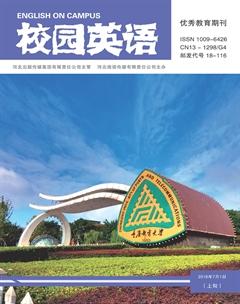“以聽(tīng)促說(shuō)”有效提高中學(xué)生英語(yǔ)聽(tīng)說(shuō)能力
第五秀蘭
為了提高學(xué)生的口語(yǔ)表達(dá)能力,作者在英語(yǔ)教學(xué)實(shí)踐中嘗試了“以聽(tīng)促說(shuō)”的教學(xué)方式,取得了良好的效果。
根據(jù)新課程標(biāo)準(zhǔn)的要求,運(yùn)用英語(yǔ)聽(tīng)力三段式教學(xué)即聽(tīng)前,聽(tīng)中,聽(tīng)后三段式來(lái)優(yōu)化聽(tīng)說(shuō)教學(xué),提高學(xué)生聽(tīng)說(shuō)能力。在運(yùn)用聽(tīng)力三段式進(jìn)行教學(xué)的過(guò)程中穿插學(xué)生的口語(yǔ)活動(dòng),鍛煉學(xué)生的聽(tīng)說(shuō)能力。
下面筆者將以人教版必修二第四單元《wildlife protection》的三段式聽(tīng)力教學(xué)設(shè)計(jì)為案例進(jìn)行探討和分析。
一、Before-listening:熱身導(dǎo)入,預(yù)測(cè)文本,做好鋪墊
聽(tīng)前,讓學(xué)生看野生動(dòng)物圖片,猜測(cè)動(dòng)物名稱,以問(wèn)題的形式導(dǎo)入文本。引發(fā)學(xué)生思考和討論,為聽(tīng)力信息的獲取和口語(yǔ)表達(dá)活動(dòng)的進(jìn)行做好鋪墊。
Step1. Lead-in(Before-listening, show some pictures of wild animals to the students)
T: Why do we never see these animals?
S: Because they are extinct.
T: Why are they endangered?
S1: Human beings often hunt them for their fur and meat.
S2: People cut down trees.
S3: Their habitats are destroyed. They are homeless.
T: Wonderful! What should we do for it?
【設(shè)計(jì)分析】本單元話題是wildlife protection,通過(guò)欣賞野生動(dòng)物圖片,引起學(xué)生興趣,以問(wèn)題為中心展開(kāi)話題討論,學(xué)生換位思考野生動(dòng)物瀕臨滅絕的原因,身臨其境,模仿動(dòng)物傳達(dá)心聲,給學(xué)生創(chuàng)造了一個(gè)良好的語(yǔ)言情境。
Step2. Presentation
T: Suppose you are one of the wild animals, what would you like to tell human beings?
S1: Dont hurt us. Especially dont destroy our homes, otherwise we are homeless!
S2: If you dont follow our advice, you will face giant disasters in the future.
【設(shè)計(jì)分析】依托“動(dòng)物瀕臨滅絕”的話題,引入新話題“渡渡鳥(niǎo)的故事”,設(shè)置恰當(dāng)?shù)恼Z(yǔ)言情境, 激發(fā)學(xué)生回憶相關(guān)的背景知識(shí),通過(guò)舊知識(shí)激活英語(yǔ)思維,積極建構(gòu)新的語(yǔ)言知識(shí)。
二、While-listening:聽(tīng)說(shuō)結(jié)合,感知文本,獲取信息
聽(tīng)中,創(chuàng)設(shè)語(yǔ)言情境,讓學(xué)生身臨其境,體悟渡渡鳥(niǎo)的艱難處境,感知文本內(nèi)容,獲取文本關(guān)鍵信息。
Step1.Listen to the materials and tell the main idea.
T: Look at the picture of the dodo. Guess what happened to the dodo?
S: Maybe the dodo disappeared. We have never seen this kind of bird.
T: Good. Guess what the reason might be for its disappearance.
S: Because of human beings destruction...
T: What is the main idea?
S: This is the story of how the dodo disappeared forever.
T: Well done!
【設(shè)計(jì)分析】在聽(tīng)前,讓學(xué)生觀看渡渡鳥(niǎo)的圖片,來(lái)預(yù)測(cè)文本內(nèi)容,通過(guò)泛聽(tīng),來(lái)訓(xùn)練學(xué)生快速把握文本大意,整體感知文本。
Step2 Continue listening to the materials, and then answer in pairs.
【設(shè)計(jì)分析】繼續(xù)聽(tīng)一遍,讓學(xué)生對(duì)文本信息有更深層次的了解,捕捉更多的細(xì)節(jié)內(nèi)容,通過(guò)相互問(wèn)答陳述聽(tīng)力材料中的關(guān)鍵信息,給學(xué)生創(chuàng)設(shè)更多的練習(xí)口語(yǔ)的機(jī)會(huì)。
Step3 Listen and repeat
T: Now listen to the materials again,please speak out the mood of the dodo.
【設(shè)計(jì)分析】反復(fù)循聽(tīng)重點(diǎn)句子,要求學(xué)生跟讀模仿語(yǔ)音語(yǔ)調(diào),目的使學(xué)生對(duì)聽(tīng)力材料的有更深刻的理解。既利于培養(yǎng)學(xué)生的“精聽(tīng)”能力,又利于培養(yǎng)學(xué)生的注意力和快速反應(yīng)能力。
三、After-listening:內(nèi)化文本,編演對(duì)話,學(xué)以致用
聽(tīng)后,以學(xué)生為主體,以任務(wù)為主線,設(shè)計(jì)兩兩對(duì)話,要求學(xué)生用自己的語(yǔ)言編演文本內(nèi)容,內(nèi)化聽(tīng)力材料,作報(bào)告與制作海報(bào),希望達(dá)到學(xué)以致用的目的。
Step1. Ask and answer freely.
T: Ask the students to answer the following questions according to what you have heard.
【設(shè)計(jì)分析】通過(guò)生生互動(dòng),來(lái)深化對(duì)文本的理解,將聽(tīng)力材料系統(tǒng)化,保證語(yǔ)言思維的連貫性。目的是通過(guò)聽(tīng)力材料,培養(yǎng)學(xué)生的口語(yǔ)表達(dá)能力。
Step2. Play the role.
Ask students to make up the dialogues. Divide them into six groups. Ask students to act out in front of the class. Which group is the best?
【設(shè)計(jì)分析】要求學(xué)生將所聽(tīng)的材料進(jìn)行思考,分組討論,扮演角色,進(jìn)行編演會(huì)話,深入體悟渡渡鳥(niǎo)的處境。目的為了培養(yǎng)學(xué)生的主動(dòng)參與,合作探究的意識(shí)。
Step3. Make a report.
T: Now make a report and put up it in the form of a poster to advocate people to protect the wildlife.
【設(shè)計(jì)分析】通過(guò)做一個(gè)報(bào)告并以海報(bào)的形式張貼出來(lái),以期倡議人們保護(hù)野生動(dòng)植物,來(lái)訓(xùn)練學(xué)生運(yùn)用英語(yǔ)做事的能力。
總之,英語(yǔ)學(xué)習(xí)是一個(gè)動(dòng)態(tài)生成的過(guò)程,聽(tīng)說(shuō)訓(xùn)練緊密相連,不可分割。因此教師在上英語(yǔ)課時(shí),應(yīng)該將聽(tīng)力教學(xué)與口語(yǔ)教學(xué)緊密結(jié)合,同時(shí)給學(xué)生創(chuàng)造語(yǔ)言環(huán)境,培養(yǎng)學(xué)生聽(tīng)說(shuō)能力和綜合語(yǔ)用能力。
參考文獻(xiàn):
[1]吳瑋.高中英語(yǔ)“以聽(tīng)促寫(xiě)”教學(xué)實(shí)踐研究[J].中小學(xué)外語(yǔ)教學(xué)與研究,2015,(11).

